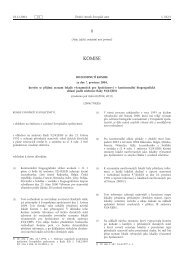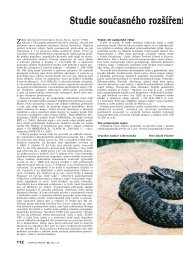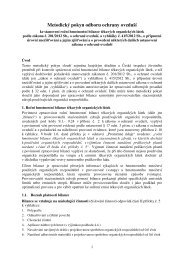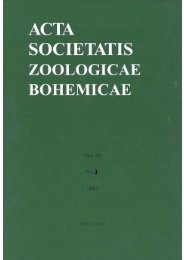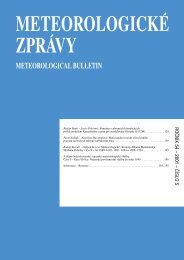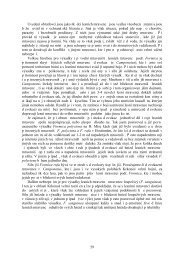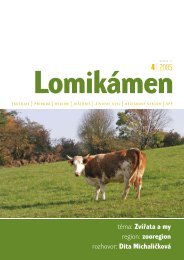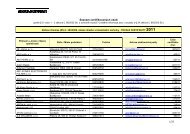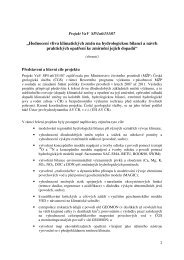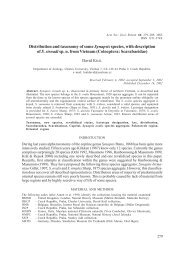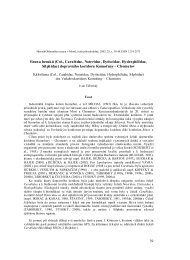journal of forest science
journal of forest science
journal of forest science
Create successful ePaper yourself
Turn your PDF publications into a flip-book with our unique Google optimized e-Paper software.
Table 1. The factor values for passing points extracted by fuzzy reasoning inference mechanism<br />
Passing points Factor values for passing points extracted by inference mechanism<br />
(Points extracted by fuzzy factor_1 factor_2 factor_3 factor_4<br />
reasoning inference mechanism) (m) (%) (m) (m)<br />
A. 196 7.7 157 14.6<br />
B. 196 7.2 142 12.1<br />
C. 189 7.5 90 12.0<br />
D. 194 7.0 173 14.4<br />
E. 187 8.5 132 13.5<br />
F. 199 6.0 116 11.6<br />
G. 199 5.4 164 8.4<br />
H. 194 7.6 118 10.6<br />
CH. 194 7.8 94 14.2<br />
I. 197 5.37 115 8.9<br />
J. 187 3.3 157 5.8<br />
By using a Vertical actor (V), we can take into account<br />
the cost necessary to overcome the slope between<br />
two cells. The value <strong>of</strong> V depends on the vertical relative<br />
moving angle – VRMA (see ESRI 1994) and is defined<br />
in our system as shown in ig. 5:<br />
V = 1 if (0 ≤ VRMA ≤ 6)<br />
V = ∞ if (6 < VRMA < 90)<br />
V = 1 if (0 ≥ VRMA ≥–6)<br />
V = ∞ if (–6 > VRMA >–90)<br />
The VRMA is limited to 6 degrees following the maximum<br />
gradient <strong>of</strong> hauling road acceptable for Slovak terrain<br />
conditions.<br />
RESULTS<br />
The new cartographic model <strong>of</strong> skyline yarding distances<br />
built for ArcInfo TM GRID environment and SDSS<br />
system were verified in a called Zboj river included in<br />
the working-plan area Zboj. The study area is approximately<br />
2,400 ha in size and situated in the Bukovské<br />
Vrchy Mountains in Eastern Slovakia. The area is configured<br />
with high undulations and an average slope gradient<br />
is 45%. Steep slopes above 40% occupy about 50%<br />
<strong>of</strong> area.<br />
Fig. 6. A <strong>forest</strong> road laid out using fuzzy reasoning system and<br />
directional path distance model<br />
The hauling road density is 26 m/ha, <strong>of</strong> which 22 m/ha<br />
are not paved hauling roads. The density <strong>of</strong> permanent<br />
ground skidding roads is about 17 m/ha. The calculated<br />
<strong>forest</strong> road density and the theoretical value <strong>of</strong> area accessibility<br />
show very good possibilities for opening the<br />
<strong>forest</strong> up. Nevertheless, in terms <strong>of</strong> the <strong>forest</strong> tractor skidding<br />
technologies used terrain conditions and existing<br />
road structures indicate that average skidding tractor distance<br />
is in reality very long, approximately 2,000 m (see<br />
also comments in Introduction).<br />
ig. 6 shows the recommended contour road proposal<br />
compared with the existing roads. Points A ~ J are passing<br />
points selected by using a fuzzy reasoning inference<br />
mechanism which is based on linear functions for decision<br />
rules. actor values for passing points extracted by<br />
the inference mechanism can be seen in Table 1. Point<br />
“P” is a starting point and “K” an ending point which is<br />
selected by the user. It is apparent from the given figures<br />
that the system takes into account terrain conditions in<br />
the layout <strong>of</strong> roads and that the proposed output is very<br />
similar to the existing road.<br />
This system, which automatically lays out the <strong>forest</strong><br />
roads, was mainly designed to take into consideration<br />
terrain conditions, but supplementary sources <strong>of</strong> information<br />
can be used too. Difficult terrain features, e.g.<br />
extreme slopes, rockiness, environmental barriers, places<br />
where yarding distances exceed the technological<br />
length <strong>of</strong> a cableway system route may be identified in<br />
the model system. These defined features (negative barriers)<br />
cause difficulties in the planning <strong>of</strong> new roads. The<br />
system eliminates negative areas from being considered<br />
and thus ensures that <strong>forest</strong> roads will avoid these areas.<br />
The information derived about skidding distances can<br />
support decision-making on where a new road is to be<br />
located and where existing ground skidding roads can be<br />
proposed for sanitation. The project <strong>of</strong> locating new sections<br />
<strong>of</strong> hauling roads was based on the idea that the skyline<br />
yarding distances between the new road and the<br />
existing valley road or contour road should not exceed<br />
the length <strong>of</strong> the maximum effective span for the proposed<br />
cableway system route. LARIX 550 (Czech Republic<br />
origin) is the most frequently used cableway<br />
J. FOR. SCI., 47, 2001 (7): 307–313 311



